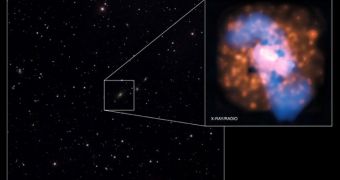Experts using the NASA Chandra X-ray Observatory discovered one of the most peculiar black holes ever. The cosmic structure has apparently been knocked off its own axis twice throughout its history, most likely following violent collisions between two galaxies. Researchers say that these are the only cosmic event sufficiently powerful to illicit such changes in the behavior of a structure such as a black hole. It is known, for example, that galactic mergers can produce supermassive black holes, by combining the smaller structures at the core of each individual galaxy, Space reports.
“We think that this black hole has quite a history. Not once, but twice, something has caused this black hole to change its spin axis,” University of Maryland astronomer Christopher Reynolds says. He is also a coauthor of a new study detailing the odd celestial body, which appears in a recent issue of the esteemed scientific publication Astrophysical Journal Letters. What makes this black holes stand out from other similar structures is the fact that the collisions it was subjected to did not change its location, but only its spin. This is an extremely rare occurrence, and astronomers are determined to analyze the peculiar body thoroughly.
“We think this is the best evidence ever seen for a black hole having been jerked around like this. We're not exactly sure what caused this behavior, but it was probably triggered by a collision between two galaxies,” says expert Edmund Hodges-Kluck, who is also based at the University of Maryland. The scientist was the lead author of the new investigation. He explains that the black hole is located in a galaxy known as 4C +00.58, which is located no less than 780 million light-years away from Earth. In addition to bearing the marks of past collisions, the central feature in this galaxy also stands out due to the particular radio signature it gives out.
Due to the large size this black hole has, it gobbles up large amounts of gas from its surroundings. This means that a large accretion disk is located around its event horizon. This feature contains swirls of gas and other types of matter, which is heated to incredible temperatures by the incredible friction forces at work there. When this happens, radio radiation is emitted, and astronomers can pick this type of light up using specialized detectors. When looking at this black hole, researchers found two separate pairs of jets, one more intense than the other. The dimmer ones were spinning in a completely opposite direction, which means that they are the remnants of the original spin the black hole had.

 14 DAY TRIAL //
14 DAY TRIAL //